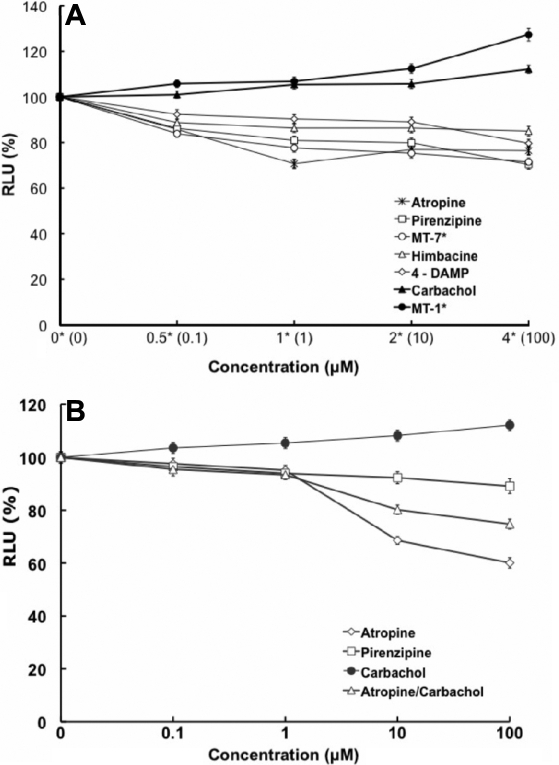Figure 6.
Muscarinic agents and mouse scleral fibroblast cell proliferation. A: The effect of muscarinic agents on mouse scleral fibroblast cell proliferation is illustrated on the graph. SFs were incubated with atropine, pirenzepine, carbachol, himbacine, and 4-DAMP at 0.1–100 μM and with muscarinic toxin-7 (MT-7), muscarinic toxin-1 (MT-1) at 0.1, 1, 2, 4 μM all for 24 h, and BrdU incorporation was measured by ELISA. Antagonists significantly inhibited DNA synthesis in a dose-dependent manner (p<0.05, ANOVA, n=4). In contrast, muscarinic receptor agonists, carbachol and MT-1, increased cell proliferation in a dose-dependent manner (p<0.05, ANOVA, n=4). Data are represented as mean±SEM. The asterisk indicates p<0.05 versus control (Post Hoc Analysis; Tukey Honest Significant Difference). B: Effects of muscarinic agents on cell proliferation of human scleral fibroblasts are shown. Scleral fibroblasts were incubated with atropine, pirenzepine, carbachol, and atropine/carbachol at 0.1–100 μM for 24 h, and BrdU incorporation was measured by ELISA. Antagonists significantly inhibited DNA synthesis in a dose-dependent manner (p<0.05, ANOVA, n=4). In contrast, muscarinic receptor agonist, carbachol, increased cell proliferation in a dose-dependent manner (p<0.05, ANOVA, n=4). Atropine was more effective at 10 and 100 μM than pirenzepine at all of the concentrations. Data are represented as mean±SEM. The asterisk indicates p<0.05 versus control (Post Hoc Analysis; Tukey Honest Significant Difference).

